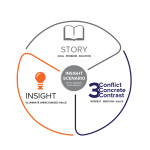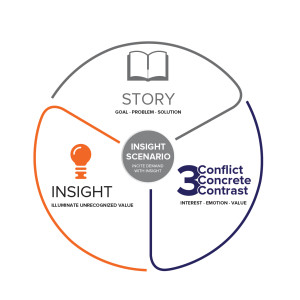 Success stories are effective to use as proof and reinforcement late in the buying cycle once a customer has already formed a complete buying vision that fully recognizes “why change?” and “why you?”
Success stories are effective to use as proof and reinforcement late in the buying cycle once a customer has already formed a complete buying vision that fully recognizes “why change?” and “why you?”
These stories are easy to tell because you’re providing proof to a customer who has already recognized that he or she has a problem that your solution can solve. Success stories are effective because they gloss over the problem so that they can focus on the solution as proof.
The problem is that the vast majority of customers at any stage of the sales cycle are not yet sold on why they should change or why they should change through you. These customers are not looking for proof of a solution to a problem they don’t yet think they have. Without a full appreciation of the value of your product, your salespeople will be forced to follow the customer down the road of commoditization and discounting when the customer decides to buy, or no decision when he or she does not decide to buy.
With 60-70% of enterprise sales opportunities ending in no decision, there is a huge opportunity for salespeople to learn to tell a more effective story that not only provides proof, but also inspires customers to change.
To inspire change, salespeople must learn to tell a new type of story, one that shines a light of insight on customers so they realize they aren’t ankle-deep in problems but are, in fact, drowning in problems before salespeople step forward to rescue these customers with their solution. We call this new type of story an Insight Scenario.
Success stories fail to inspire customers to change and buy your product for the following six reasons:
1. Sells Solution vs. Sells the Problem
Success stories gloss over the problem so they can focus on the solution as proof. As a result, they provide only a superficial reason to change, such as the customer’s current system lacks ‘timeliness’ or is ‘prone to error.’ The reasons do little to inspire customers to change. Insight Scenarios, on the other hand, flip the problem-solution ratio upside-down because salespeople must open before they can close. By increasing the time spent developing the problem from 25% to 75%, Insight Scenarios allow the salesperson to sell the problem before the solution.
2. Abstract vs. Concrete
Success stories are about companies solving abstract problems, so they leave it to customers to figure out how they could use the seller’s product to solve their problem. Insight Scenarios, on the other hand, provide context by asking “So then what happens?” until they tell the story of a specific person solving a real problem by using the seller’s product.
3. Sameness vs. Contrast
Success stories are vague about the problem and specific about the solution. Insight Scenarios, on the other hand, create a clear contrast between “hell” if customers don’t buy your product and “heaven” if they do. As a result, customers are inspired to change because the risk to the status quo now feels greater than the cost of the seller’s solution along with the risk of change.
4. Monologue vs. Dialogue
Success stories are sales conversation-killing monologues that flood customers with far too much information. Insight Scenarios, on the other hand, are limited to addressing only one point per story. They are designed to deliver short bursts of insight in less than two minutes to start a dialogue in which customers start to tell themselves a new story in which new choices make more sense.
5. Repels vs. Attracts
Success stories are usually about a seller who rides in on a white horse and rescues the poor hapless customer. But customers don’t want to see themselves as the loser in your story. Insight Scenarios, on the other hand, always make buyers or their employees the heroes of the story and make an outside force, such as changes in technology or regulations, the villain. As a result, Insight Scenarios attract rather than repel customers.
6. Irrelevant vs. Relevant
Success stories are about how the seller rescued the customer. But if the customer doesn’t yet fully recognize his or her problem, the story will have little relevance. The purpose of an Insight Scenario, on the other hand, is to shine a light on unrecognized customer value so that the Insight Scenario closes the value gap.
So it’s easy to learn how to tell a success story, but it’s challenging to tell a relevant story that inspires a customer to change. Did you know, for example, that 7 out of 10 Hollywood films lose money, 1 breaks-even, and only 2 out of 10 make money? Even though Hollywood has more money than God to hire the best script writers and other creative thinkers, most films fail. However, in sales, unlike Hollywood, our stories can’t just entertain. They must inspire customers to change, and we do that by delivering an Insight Scenario.
Salespeople need to know how to convert their success stories into Insight Scenarios that are unique to the specific company, title, and gap they are trying to fill. They must first sell the idea conversationally through a series of insight scenarios before they can leave behind the success story as proof.
-Michael


